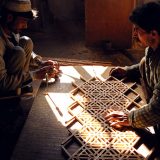When Miniature went the Mughal way…


Kangra miniature painting Artist
He sits cross-legged in the lap of hills. He has a knowing, settled air to him. A brush of fine bristles is held in his secure hand and the contours slowly become visible of a thing; beautiful, that shall transcend time. A story has to be told… The mountainous backdrop, the trees, the rivers, the birds, the sounds, the voices, all partake with the painter.
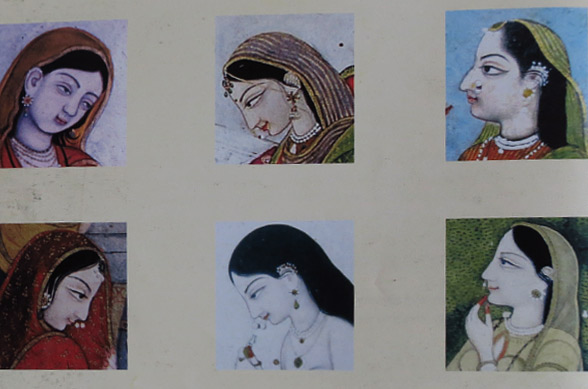
A group of women, beautiful maidens; firm, shapely bosoms, lustrous skins, chiseled faces, fish shaped eyes, full lips, slender and curvy; like one of those gorgeous snow capped curves in the pristine hilly backdrop, perfectly morphing into it…. their long hair, their beautiful attire, fluid and translucent; just enough to show their well formed figures, their ornaments; of gold and colorful gems, adding regale to their understated beauty… They are all looking for their playful lover -Krishna, who seems to be at his tricks again…. This along with many other narratives from the Bhagvad Purana or Jaidev’s Gita- Govinda form the theme for the paintings taking form in the beautiful Kangra valley. The miniatures feel to be a natural outcome.
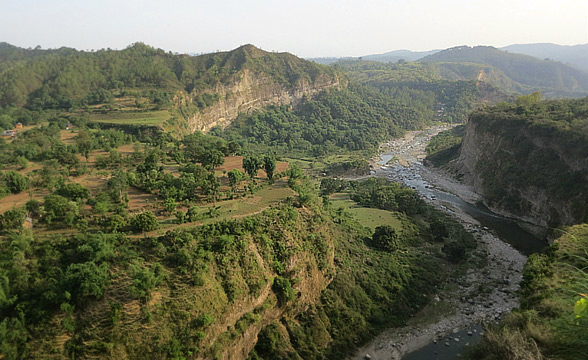
Nadir Shah’s invasion of the northern states led the Kashmiri painters from the Mughal ateliers to seek patronage with the Rajput kings. A family of painters from Kashmir, with a trained hand in the Mughal style, reached out to Raja Dalip Singh for a roof over their heads. He ruled Guler, a town in the Lower Himalayas. It stands at the entrance of the valley bordering on the plains. The family saw the local art sensibilities, the Mughal way. A new form was born. The same stories found a new narrative arc.

Patronage of Maharaja Sansar Chand, a Krishna lover, saw the commissions flowing in, the art sustained and flourished. A painting that sits in the Chadigarh museum at the moment shows Raja Govardhan Chand of Guler sitting on the terrace enjoying music. It marks the transition of the art form to Mughal style….
Thereafter Mahabharata, Ramayana, the idyllic Radha Krishna found new kind of brush strokes. The colour tones became softer, the palette simpler and the experience sublime. The hills, the Himalayan houses, the trees and the vastness of the valleys became the backdrop for Radha and Krishna’s togetherness. Krishna’s turban and Radha’s Ghaghra took a Mughal spirit. Vibrant and elaborated, detailed and intricate, the narratives have a different sort of playfulness. Refined and fine lines, extraordinarily beautiful women, like the flower blossom she would hold in her hands. This shift from dramatic to realistic wasn’t subtle.
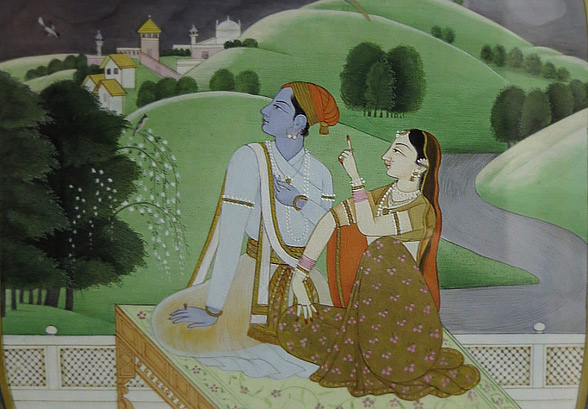
The preliminary sketch leads to application of Khadiya, a white paste to fill the holes that the paper might carry. An agate stone comes in; it is rubbed to burnish the paper before the brush, the colors all start to play shades, lines, forms and purpose.

Long time ago, his ancestors sported color stains in far greater number than his hands, his face and his clothes carry now. The natural world was their world. The colors used for the paintings; white, red, orange, mahavar (alta), yellow, green, blue, black, silver/gold (halakari), gond (babul tree), still keep the natural connection intact, just better organized.
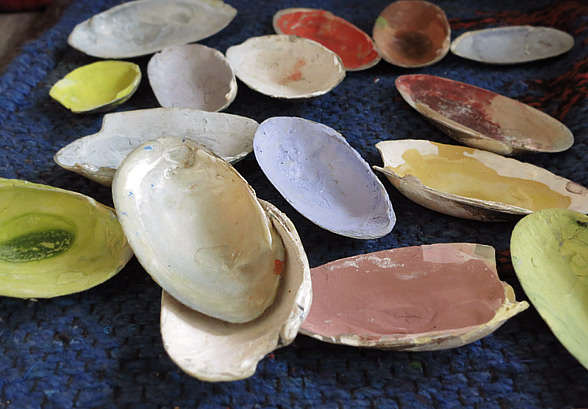
Tales of nature’s moods influencing ours taken from Baramasa by Keshavdas, the story of Nala and Damayanti, the Shringar Rasa (the erotic emotion) also took birth on the canvas. Nayika Bheda, a text, part of Natya Shashtra, classified the Nayika (heroine) in various states in relation to her lover (Nayak). Eight women in one woman…. Distressed on separation, nervous before union, pleased at subjection, separated on differences, enraged and jealous, betrayed and longing, and the stealthy one who secretly crosses rivers and averts storms to see her lover. Hugely popular atthe time also flowed onto the canvas.
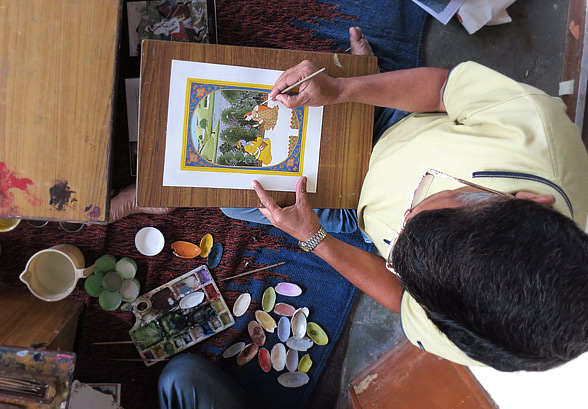
The word Pahari (from the hills) is used generically for all the paintings originating in the hill states. Nurpur, Basohli and Chamba also offer miniatures of a less refined taste but emotionally intense. Love for the hills and valleys or longing for idyllic women and enchanting colors has timelessly been in the human fabric… and so the stories depicted in these miniatures have fascinated, influenced,and formed minds for centuries. Stories are mirrors, if you really look.
Read more About Kangra Miniature ~ Gaatha.org


